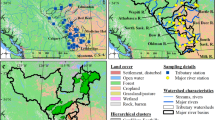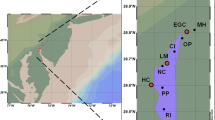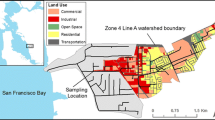Abstract
Mercury (Hg) concentrations and speciation were measured in nine tributaries to Lake Ontario as part of two independent field-sampling programs. Among the study tributaries, mean total Hg (THg) concentrations ranged from 0.9 to 2.6 ng/L; mean dissolved Hg (THgD) ranged from 0.5 to 1.5 ng/L; mean particulate Hg (THgP) ranged from 0.3 to 2.0 ng/L; and mean methylmercury (MeHg) ranged from 0.06 to 0.14 ng/L. Watershed land cover, total suspended solids (TSS), and dissolved organic carbon (DOC) were evaluated as potential controls of tributary Hg. Significant relationships between THgD and DOC were limited, whereas significant relationships between THgP and TSS were common across watersheds. Total suspended solids was strongly correlated with the percentage of agricultural land in watersheds. Particle enrichment of Hg (mass Hg/mass TSS) was highly variable, but distinctly higher in US tributaries likely due to higher TSS in Canadian tributaries associated with higher urban and agricultural land cover. MeHg was largely associated with the aqueous phase, and MeHg as a fraction of THg was positively correlated to percent open water coverage in the watershed. Wetland cover was positively correlated to THg and MeHg concentrations, while urban land cover was only related to higher THgP.



Similar content being viewed by others
References
Babiarz CL, Hurley JP, Benoit JM, Shafer MM, Andren AW, Webb DA (1998) Seasonal influences on partitioning and transport of total and methylmercury in rivers from contrasting watersheds. Biogeochemistry 41:237–257. https://doi.org/10.1023/A:1005940630948
Back RC, Gorski PR, Cleckner LB, Hurley JP (2003) Mercury content and speciation in the plankton and benthos of Lake Superior. Sci Total Environ 304:349–354
Balogh SJ, Huang YB, Offerman HJ, Meyer ML, Johnson DK (2003) Methylmercury in rivers draining cultivated watersheds. Sci Total Environ 304:305–313
Balogh SJ, Meyer ML, Johnson DK (1998) Transport of mercury in three contrasting river basins. Environ Sci Technol 32:456–462
Balogh SJ, Nollet YH, Offerman HJ (2005) A comparison of total mercury and methylmercury export from various Minnesota watersheds. Sci Total Environ 340:261–270
Balogh SJ, Engstrom DR, Almendinger JE, McDermott C, Hu J, Nollet YH, Meyer ML, Johnson DK (2009) A sediment record of trace metal loadings in the Upper Mississippi River. J Paleolimnol 41:623–639. https://doi.org/10.1007/s10933-008-9295-2
Bloom N (1989) Determination of picogram levels of methylmercury by aqueous phase ethylation, followed by cryogenic gas-chromatography with cold vapor atomic fluorescence detection. Can J Fish Aquat Sci 46:1131–1140
Bradley PM et al. (2011) Spatial and seasonal variability of dissolved methylmercury in two stream basins in the Eastern United States. Environ Sci Technol 45:2048–2055
Bullock OR, Brehme KA (2002) Atmospheric mercury simulation using the CMAQ model: formulation description and analysis of wet deposition results. Atmos Environ 36:2135–2146
Burns DA, Riva-Murray K, Bradley PM, Aiken GR, Brigham ME (2012) Landscape controls on total and methyl Hg in the upper Hudson River basin, New York, USA. J. Geophys. Res. Biogeosci. 117. https://doi.org/10.1029/2011JG001812
Cai Y, Jaffe R, Jones RD (1999) Interactions between dissolved organic carbon and mercury species in surface waters of the Florida Everglades. Appl Geochem 14:395–407
Choi HD, Sharac TJ, Holsen TM (2008) Mercury deposition in the Adirondacks: a comparison between precipitation and throughfall. Atmos Environ 42:1818–1827
Demers JD, Driscoll CT, Shanley JB (2010) Mercury mobilization and episodic stream acidification during snowmelt: role of hydrologic flow paths, source areas, and supply of dissolved organic carbon. Water Resour Res 46. https://doi.org/10.1029/2008WR007021
Denkenberger JS, Driscoll CT, Branfireun BA, Eckley CS, Cohen M, Selvendiran P (2012) A synthesis of rates and controls on elemental mercury evasion in the Great Lakes Basin. Environ Pollut 161:291–298
Denkenberger JS, Driscoll CT, Mason E, Branfireun B, Warnock A (2014) A fluvial mercury budget for Lake Ontario. Environ Sci Technol 48:6107–6114
Dennis IF et al. (2005) Distribution patterns of mercury in lakes and rivers of northeastern North America. Ecotoxicology 14:113–123
Dittman JA, Driscoll CT, Groffman PM, Fahey TJ (2007) Dynamics of nitrogen and dissolved organic carbon at the Hubbard Brook Experimental Forest. Ecology 88:1153–1166
Dittman JA, Shanley JB, Driscoll CT, Aiken GR, Chalmers AT, Towse JE, Selvendiran P (2010) Mercury dynamics in relation to dissolved organic carbon concentration and quality during high flow events in three northeastern US streams. Water Resour. Res. 46. https://doi.org/10.1029/2009WR008351
Drevnick PE et al. (2012) Spatial and temporal patterns of mercury accumulation in lacustrine sediments across the Laurentian Great Lakes region. Environ Pollut 161:252–260
Driscoll CT, Blette V, Yan C, Schofield CL, Munson R, Holsapple J (1995) The role of dissolved organic-carbon in the chemistry and bioavailability of mercury in remote Adirondack lakes. Water Air Soil Poll 80:499–508
Driscoll CT, Mason RP, Chan HM, Jacob DJ, Pirrone N (2013) Mercury as a global pollutant: Sources, pathways, and effects. Environ Sci Technol 47:4967–4983
Driscoll CT, Yan C, Schofield CL, Munson R, Holsapple J (1994) The mercury cycle and fish in the Adirondack lakes. Environ Sci Technol 28:A136–A143
Eaton AD, Clesceri LS, Greenberg AE, Franson MA (1998) Standard Methods for the Examination of Water and Wastewater. 20th edn. American Public Health Association, Washington DC
Evers DC et al. (2008) Adverse effects from environmental mercury loads on breeding common loons. Ecotoxicology 17:69–81
Evers DC, Wiener JG, Driscoll CT, Gay DA, Basu N, Monson BA, Lambert KF, Morrison HA, Morgan JT, Williams KA, Soehl AG (2011) Great Lakes mercury connections: the extent and effects of mercury pollution in the Great Lakes Region. Biodiversity Research Institute. Gorham, Maine. Report BRI 2011–18. 44 pages
Fitzgerald WF, Engstrom DR, Mason RP, Nater EA (1998) The case for atmospheric mercury contamination in remote areas. Environ Sci Technol 32:1–7
Fitzgerald WF, Mason RP, Vandal GM (1991) Atmospheric cycling and air-water exchange of mercury over midcontinental lacustrine regions. Water Air Soil Poll 56:745–767
Government of Canada EC (2007) Environment Canada - pollution and waste - fish consumption advisories. http://www.ec.gc.ca/mercure-mercury/default.asp?lang=En&n=DCBE5083-1. Accessed 25 Jun 2013
Helsel DR (1990) Less than obvious - statistical treatment of data below the detection limit. Environ Sci Technol 24:1766–1774
Heitmann T, Blodau C (2006) Oxidation and incorporation of hydrogen sulfide by dissolved organic matter. Chem Geol 235:12–20
Hurley JP et al. (1995) Influences of watershed characteristics on mercury levels in Wisconsin rivers. Environ Sci Technol 29:1867–1875
Hurley JP, Cowell SE, Shafer MM, Hughes PE (1998b) Partitioning and transport of total and methyl mercury in the Lower Fox River, Wisconsin. Environ Sci Technol 32:1424–1432
Hurley JP, Cowell SE, Shafer MM, Hughes PE (1998a) Tributary loading of mercury to Lake Michigan: importance of seasonal events and phase partitioning. Sci Total Environ 213:129–137
Hurley JP, Krabbenhoft DP, Babiarz CL, Andren AW (1994) Cycling of mercury across the sediment-water interface in seepage lakes. Adv Chem Ser 237:425–449
Hurley JP, Krabbenhoft DP, Cleckner LB, Gilmour CC, Olson ML (1996) Spatial and temporal patterns of mercury speciation in the northern Everglades. Abstr Pap Am Chem S 212:76–Geoc
Hurley JP et al. (2003) Methyl mercury in Lake Superior: offshore processes and bioaccumulation. J Phys Iv 107:641–644
Hurley JP, Shafer MM, Cowell SE, Overdier JT, Hughes PE, Armstrong DE (1996) Trace metal assessment of Lake Michigan tributaries using low-level techniques. Environ Sci Technol 30:2093–2098
Kolka RK, Grigal DF, Verry ES, Nater EA (1999) Mercury and organic carbon relationships in streams draining forested upland/peatland watersheds. J Environ Qual 28(3):766–775
Lai SO et al. (2007) Estimation of mercury loadings to Lake Ontario: results from the Lake Ontario atmospheric deposition study (LOADS). Atmos Environ 41:8205–8218
Lawson NM, Mason RP, Laporte JM (2001) The fate and transport of mercury, methylmercury, and other trace metals in Chesapeake Bay tributaries. Water Res 35:501–515
Lepak RF, Yin RS, Krabbenhoft DP, Ogorek JM, DeWild JF, Holsen TM, Hurley JP (2015) Use of stable isotope signatures to determine mercury sources in the Great Lakes. Environ Sci Tech Let 2:335–341
Lyons WB, Fitzgibbon TO, Welch KA, Carey AE (2006) Mercury geochemistry of the Scioto River, Ohio: impact of agriculture and urbanization. Appl Geochem 21:1880–1888
Mahaffey K (2004) Update on recent epidemiologic mercury studies. In Proceedings of the 2004 national forum on contaminants in fish. EPA-823-R-04-006.
Mason RP, Sullivan KA (1997) Mercury in Lake Michigan. Environ Sci Technol 31:942–947
Mason RP, Sullivan KA (1998) Mercury and methylmercury transport through an urban watershed. Water Res 32:321–330
Meybeck M (1982) Carbon, nitrogen, and phosphorus transport by world rivers. Am J Sci 282:401–450
Miller EK, Vanarsdale A, Keeler GJ, Chalmers A, Poissant L, Kamman NC, Brulotte R (2005) Estimation and mapping of wet and dry mercury deposition across northeastern North America. Ecotoxicology 14:53–70
Mitchell CPG, Branfireun BA, Kolka RK (2008) Total mercury and methylmercury dynamics in upland-peatland watersheds during snowmelt. Biogeochemistry 90:225–241
Munthe J et al. (2007) Recovery of mercury-contaminated fisheries. Ambio 36:33–44
Nater EA, Grigal DF (1992) Regional trends in mercury distribution across the Great-Lakes states, North Central USA. Nature 358:139–141
Natural Resources Canada/CanadianCentre for Remote Sensing, United States Geological Survey, Insituto Nacional de Estadística y Geografía, et al. (2010) 2005 North American Land Cover at 250 m spatial resolution.
NESCAUM (2005) Inventory of anthropogenic mercury emissions in the northeast. Northeast States for Coordinated Air Use Management, Boston, MA
New York State Department of Environmental Conservation (2000) New York state large scale hydrography surface water areas by sub-basin. ARC Export, New York State Department Environmental Conservation
Ontario Ministry of Natural Resources (2011) National hydro network
Paraquetti HHM, Ayres GA, de Almeida MD, Molisani MM, de Lacerda LD (2004) Mercury distribution, speciation and flux in the Sepetiba Bay tributaries, SE Brazil. Water Res 38:1439–1448
Peckenham JM, Kahl JS, Mower B (2003) Background mercury concentrations in riverwater in Maine, USA. Environ Monit Assess 89:129–152
Peterjohn WT, Correll DL (1984) Nutrient dynamics in an agricultural watershed - observations on the role of a riparian forest. Ecology 65:1466–1475
Pirrone N et al. (2010) Global mercury emissions to the atmosphere from anthropogenic and natural sources. Atmos Chem Phys 10:5951–5964
Pirrone N, I A, Keeler GJ, Nriagu JO, Rossmann R, Robbins JA (1998) Historical atmospheric mercury emissions and depositions in North America compared to mercury accumulations in sedimentary records. Atmos Environ 32:929–940
Quemerais B, Cossa D, Rondeau B, Pham TT, Fortin B (1998) Mercury distribution in relation to iron and manganese in the waters of the St. Lawrence River. Sci Total Environ 213:193–201
R Core Team (2018) R: a language and environment for statistical computing. R Foundation for Statistical Computing, Vienna, Austria. https://www.R-project.org/.
Ravichandran M (2004) Interactions between mercury and dissolved organic matter - a review. Chemosphere 55:319–331
Riscassi AL, Hokanson KJ, Scanlon TM (2011) Streamwater particulate mercury and suspended sediment dynamics in a forested headwater catchment. Water Air Soil Poll 220:23–36
Rolfhus KR et al. (2003) Distribution and fluxes of total and methylmercury in Lake Superior. Environ Sci Technol 37:865–872
Sandheinrich MB, Wiener JG (2011) Methylmercury in freshwater fish: recent advances in assessing toxicity of environmentally relevant exposures. In: WN Beyer and JP Meador (ed.). Environmental contaminants in biota: interpreting tissue concentrations, 2nd edn. Taylor and Francis Publishers, Boca Raton, Florida
Schmeltz D et al. (2011) MercNet: a national monitoring network to assess responses to changing mercury emissions in the United States. Ecotoxicology 20:1713–1725
Schuster PF et al. (2008) Mercury and organic carbon dynamics during runoff episodes from a northeastern USA watershed. Water Air Soil Poll 187:89–108
Seigneur C, Lohman K, Vijayaraghavan K, Shia RL (2003) Contributions of global and regional sources to mercury deposition in New York State. Environ Pollut 123:365–373
Sellers P, Kelly CA, Rudd JWM, MacHutchon AR (1996) Photodegradation of methylmercury in lakes. Nature 380:694–697
Selvendiran P, Driscoll CT, Bushey JT, Montesdeoca MR (2008) Wetland influence on mercury fate and transport in a temperate forested watershed. Environ Pollut 154:46–55
Shanley JB, Kamman NC, Clair TA, Chalmers A (2005) Physical controls on total and methylmercury concentrations in streams and lakes of the northeastern USA. Ecotoxicology 14:125–134
Shanley JB et al. (2008) Comparison of total mercury and methylmercury cycling at five sites using the small watershed approach. Environ Pollut 154:143–154
St. Louis VL, Rudd JWM, Kelly CA, Beaty KG, Bloom NS, Flett RJ (1994) Importance of Wetlands as Sources of Methyl Mercury to Boreal Forest Ecosystems. Can J Fish Aquat Sci 51:1065–1076 https://doi.org/10.1139/f94-106
St. Louis VL, Rudd JWM, Kelly CA, Beaty KG, Flett RJ, Roulet NT (1996) Production and Loss of Methylmercury and Loss of Total Mercury from Boreal Forest Catchments Containing Different Types of Wetlands. Environ Sci Technol 30:2719–2729 https://doi.org/10.1021/es950856h
Systat Software, Inc. (2008) SigmaPlot
Todorova SG, Driscoll CT, Matthews DA, Effler SW, Hines ME, Henry EA (2009) Evidence for regulation of monomethyl mercury by nitrate in a seasonally stratified, eutrophic lake. Environ Sci Technol 43:6572–6578
USEPA (2005) 2004 national listing of fish advisories. http://water.epa.gov/scitech/swguidance/fishshellfish/fishadvisories/archive/2004_index.cfm. Accessed 29 Mar 2012
USEPA (1996) Method 1669: sampling ambient water for trace metals at EPA water criteria levels. USEPA, National Service Center for Environmental Publications
USEPA (2002) Method 1631: mercury in water by oxidation, purge and trap, and cold vapor atomic fluorescence spectrometer. USEPA, National Service Center for Environmental Publications
USEPA (2001) Method 1630 E: guidance for implementing the January 2001 Methylmercury water quality criterion. USEPA, National Service Center for Environmental Publications
Vairavamurthy MA, Mopper K (1987) Geochemical formation of organosulphur compounds (thiols) by addition of H2S to sedimentary organic matter. Nature 329:623–625
Vairavamurthy MA, Mopper K, Taylor BF (1992) Occurrence of particle-bound polysulfides and significance of their reaction with organic matters in marine sediments. Geophys Res Lett 19:2043–2046
Wang QR, Kim D, Dionysiou DD, Sorial GA, Timberlake D (2004) Sources and remediation for mercury contamination in aquatic systems - a literature review. Environ Pollut 131:323–336
Ye Z, Mao H and Driscoll CT (2019) Impacts of anthropogenic emissions and meteorology on mercury deposition over lake vs land surface in upstate New York. Ecotoxicology 1–12.
Yu X, Driscoll CT, Warby RAF, Montesdeoca M, Johnson CE (2014) Soil mercury and its response to atmospheric mercury deposition across the northeastern United States. Ecol Appl 24:812–822
Zhou CL, Cohen MD, Crimmins BA, Zhou H, Johnson TA, Hopke PK, Holsen TM (2017) Mercury temporal trends in top predator fish of the Laurentian Great Lakes from 2004 to 2015: are concentrations still decreasing? Environ Sci Technol 51:7386–7394
Acknowledgements
This research was supported by the US Environmental Protection Agency, the Ontario Ministry of the Environment, and the Syracuse Center of Excellence through the CARTI program. Partial funding for this work was provided by the Wen-Hsiung and Kuan-Ming Li Graduate Fellowship. Field and laboratory support was provided by Mario Montesdeoca at Syracuse University and Tracie Greenberg, Tom Ulanowski, Britney Meyers, and Geoff Stupple at the University of Toronto. Ram Yerubandi at Environment Canada and Tony Zhang at the University of Toronto aided in development of discharge estimates for the Trent River. Mark Gravelding and Alain Hebert, both of ARCADIS U.S., Inc., provided additional support for manuscript development. Edward Mason was an early contributor to the work.
Funding
This research was supported by the US Environmental Protection Agency, the Ontario Ministry of the Environment, and the Syracuse Center of Excellence through the CARTI program EPA X-83232501-0.
Author information
Authors and Affiliations
Corresponding author
Ethics declarations
Conflict of interest
The authors declare that they have no conflict of interest.
Ethical approval
This article does not contain any studies with human participants or animals performed by any of the authors.
Additional information
Publisher’s note Springer Nature remains neutral with regard to jurisdictional claims in published maps and institutional affiliations.
Supplementary information
Rights and permissions
About this article
Cite this article
Denkenberger, J.S., Fakhraei, H., Branfireun, B. et al. Watershed influences on mercury in tributaries to Lake Ontario. Ecotoxicology 29, 1614–1626 (2020). https://doi.org/10.1007/s10646-019-02157-4
Accepted:
Published:
Issue Date:
DOI: https://doi.org/10.1007/s10646-019-02157-4




